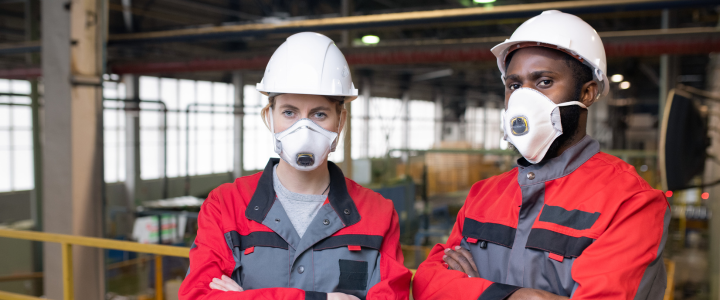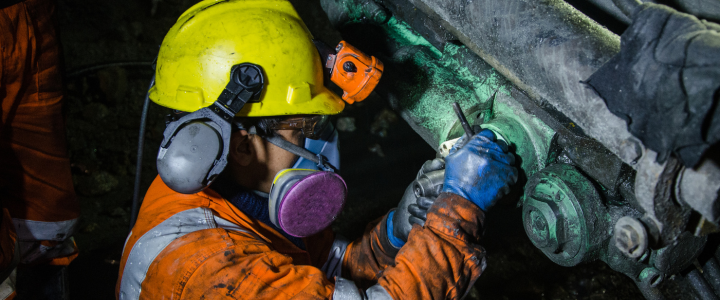Ensuring the health and safety of workers is paramount in any workplace, especially in industries where employees are exposed to harmful airborne contaminants. The Occupational Safety and Health Administration (OSHA) Respiratory Protection Standard is a crucial regulation designed to safeguard workers from respiratory hazards. In this guide, we will explore the importance of OSHA’s standard, its key components, and the guidelines for implementing an effective respiratory protection program.
Potential Workplace Respiratory Hazards
Respiratory hazards in the workplace can pose significant risks. Some common types of respiratory hazards include:
- Oxygen-Deficient Atmospheres: An oxygen-deficient atmosphere is one where the oxygen concentration is below the normal level of 19.5%. This can occur in confined spaces with poor ventilation or in areas where oxygen is displaced by other gases or substances. Workers exposed to oxygen-deficient atmospheres may experience dizziness, shortness of breath, and even loss of consciousness.
- Asphyxiants: Asphyxiants are substances that can deprive living tissues of oxygen. They can be classified into simple and chemical asphyxiants. Simple asphyxiants are usually physiologically inert gases that accumulate in sufficient quantities to prevent an adequate amount of oxygen from reaching body tissues. Chemical asphyxiants, on the other hand, chemically react with the body to interfere with oxygen transport or utilization. Examples of asphyxiants include nitrogen, carbon dioxide, and hydrogen sulfide.
- Toxic Gases and Vapors: Certain gases and vapors in the workplace can have toxic effects on the respiratory system. These include ammonia, carbon monoxide, solvents, and other harmful chemicals. Inhalation of these toxic gases and vapors can lead to irritation, respiratory distress, and long-term health effects.
- Particulate Matter: Particulate matter refers to solid or liquid particles suspended in the air, such as dust, fibers, or fumes. Inhaling these particles can cause respiratory irritation, bronchitis, and lung diseases. Common sources of particulate matter in the workplace include construction sites, industrial processes, and certain manufacturing activities.
Employers must identify and assess the respiratory hazards in their workplace, implement appropriate control measures, and provide workers with proper respiratory protection equipment when necessary. Regular monitoring, adequate ventilation systems, and training on respiratory hazards and protective measures are essential in ensuring workplace health and safety for employees.
Please note that this is just a brief overview, and it is important to consult additional sources and seek expert advice to thoroughly understand and address specific respiratory hazards in the workplace.

The Significance of the OSHA Respiratory Protection Standard
The OSHA Respiratory Protection Standard (29 CFR 1910.134) sets forth guidelines and requirements for employers to protect their workers from respiratory hazards in the workplace. This standard applies to various industries, including construction, manufacturing, healthcare, etc.
By enforcing this regulation, OSHA aims to minimize the risk of respiratory illnesses caused by exposure to hazardous substances like dust, fumes, gases, vapors, and biological agents.
Identifying Respiratory Hazards
The first step in compliance with the OSHA standard is to conduct a thorough risk assessment to identify potential respiratory hazards. Employers must determine the type and level of contaminants present to select appropriate respirators and develop an effective respiratory protection program.
Selecting Appropriate Respirators
Once respiratory hazards are identified, employers must choose eye and face protection suitable for specific workplace conditions. This involves considering factors such as the type of contaminants, exposure levels, worker health status, and comfort. Different respirator types, such as filtering facepiece respirators, half-face respirators, and powered air-purifying respirators (PAPRs), may be necessary, depending on the situation.
Employee Training and Fit Testing
An essential aspect of the respiratory protection standard is ensuring that employees are properly trained in the use, maintenance, and limitations of their assigned respirators. Additionally, fit testing is crucial to determine if the respirator forms a proper seal with the wearer’s face, ensuring its effectiveness in protecting against contaminants.
Establishing a Written Respiratory Protection Program
Employers are required to develop a comprehensive written safety and health program that outlines the procedures, policies, and responsibilities related to respiratory protection. This program must detail the selection of respirators, medical evaluations, fit testing procedures, and maintenance protocols.
Medical Evaluations and Recordkeeping
Before employees are required to wear respirators, they must undergo a medical evaluation to assess their ability to use respiratory protective equipment safely. Employers must maintain records of these evaluations, fit testing results, and other essential respiratory protection program documentation.
Regular Equipment Inspection and Maintenance
Ensuring that respirators are in proper working condition is vital for their effectiveness. Employers should establish regular inspection, cleaning, and maintenance schedules for all respiratory protective equipment.

The Bottom Line
Compliance with the OSHA respiratory protection standard is paramount in safeguarding workers’ health and well-being. By identifying respiratory hazards, providing appropriate respirators, offering thorough training, and implementing a comprehensive respiratory protection program, employers demonstrate their commitment to creating a safe and healthy work environment.
Remember — Following OSHA guidelines not only protects employees from respiratory hazards but also fosters a culture of safety and responsibility within the workplace. Together, employers and employees can work towards a healthier and more secure future!
Contact Safety By Design for Expert Advice and Safety Solutions
At Safety By Design, we emphasize the importance of incorporating safety measures into every aspect of the workplace. Our comprehensive training programs in Houston aim to proactively address potential hazards and risks, ensuring that safety is first and foremost.
Contact us today to learn more about our online OSHA training courses.



